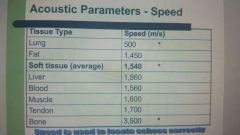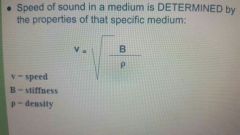![]()
![]()
![]()
Use LEFT and RIGHT arrow keys to navigate between flashcards;
Use UP and DOWN arrow keys to flip the card;
H to show hint;
A reads text to speech;
41 Cards in this Set
- Front
- Back
|
Directly Related |
An increase in one variable results in an increase in the other
• stiffness and speed are directly related Stiffness⬆ Speed ⬆ |
|
|
Inversely Related |
An increase and one result in a decrease of the other
• density and speed are inversely related Density ⬆ Speed ⬇ • period is inversely related to frequency Frequency ⬆ Period ⬇ |
|
|
Reciprocal relationship |
When variables are inversely related in an exact way instead of in a general manner |
|
|
Cosine |
Ratio of the length of site adjacent to the angle of the hypotenuse Adjacent/ hypotenuse |
|
|
Sine |
Ratio of the lengths of the side opposite the angle of the hypotenuse Opposite/ hypotenuse |
|
|
Wave |
A wave is a traveling variation and one or more quantities, such as pressure, density, & vibrations. There are two basic types wave transverse and longitudinal
|
|
|
Sound |
Sound of something that travels through a medium. That "something" is traveling variations and pressure. - sound is a wave - mechanical |
|
|
Tan |
Ratio of the length of the side opposite the angle to the side adjacent to the angle Sine/ cosine = opposite over adjacent |
|
|
Acoustic variables |
Three quantities that defines sound waves. - pressure - density - particle vibration (distance) |
|
|
Pressure |
Concentration of force in an area. • varies with time as the wave moves through the medium
Unit: pascals (Pa) |
|
|
Density |
Concentration of mass and the volume Units: kg/cm^3 |
|
|
Sound waves |
Sound propagates through air or other mediums as a longitudinal wave in which the mechanical vibration constituting the wave occurs along the direction of the propagation of the wave. -Generated by vibrating objects -Cause alternating compressions and rarefactions in the particles of the medium - the particles move back and forth in the direction of propagation of the wave |
|
|
Particle motion (distance) |
Distance (measure of particle motion)
Units: cm, ft, mile |
|
|
Longitudinal waves |
And longitudinal wave particles move along the same direction as the wave they are mechanical waves. They are made up of areas of compression also called condensation and areas of rarefaction. |
|
|
Radiowaves |
Travels at the speed of light and do not need a medium for propagation. Radiowaves are electromagnetic waves |
|
|
Transverse wave (shear waves) |
In a transverse wave the motion that constitutes the wave is perpendicular or transverse to the direction in which the wave is moving. They are electromagnetic sources such as a light or radio • fully ossified bone is the only biological tissue that can cause production of transverse waves |
|
|
Ocean waves |
Travel slower and are produced by the moon's gravitational force on Earth they are mechanical waves |
|
|
Electromagnetic waves |
Electromagnetic waves are radio waves, radar, gamma, ultraviolet, infrared, visible light, microwaves, Etc., they do not need a medium for propagation |
|
|
How does sound wave travels |
The wave travels through the medium by the progressive interaction of individual particles as they oscillate back-and-forth. The energy in the mechanical wave is transmitted through the motion of these particles - the medium itself does not move from one place to another |
|
|
Mechanical waves |
Mechanical waves propagate energy through a medium by cyclic pressure variations, they need a deformable, elastic medium like air, water, or soft tissue • mechanical waves can be either transverse or longitudinal |
|
|
Fundamentals of waves |
The fundamentals of waves are audible, ultrasound, and infrasound they have the same properties, they are all mechanical waves and are longitudinal •Audible ~ 20 - 20k cycles/sec (20-20kHz) •Ultrasound ~ >20k cycles/sec (20kHz) •Infrasound~ < 20 cycles/sec (20Hz) |
|
|
Sound |
Sound can be described as periodic changes and the pressure of medium so they can also be called pressure waves are compression waves.
|
|
|
Audible waves (human speech) |
Human speech are mechanical produced by deformation of air caused by vibration of the vocal cords in the larynx. |
|
|
Mode conversion |
Is defined as one type of wave motion being converted to another |
|
|
Surface waves |
Some ways are not simply longitudinal or transverse. Such are classified as surface waves (particle movement restricted to a thin layer at the surface of the medium supporting the waves) |
|
|
Acoustic variables |
Acoustic variables allowed to identify sound waves from other type of waves, there are three type acoustic variables: • pressure •density •distance If any one of these AV oscillates rhythmically the wave is a sound wave |
|
|
Interference |
When two or more waves combine to form a single wave |
|
|
Constructive interference |
Two in Phase waves form a single wave of Greater amplitude |
|
|
Huygen's principal |
Every point on a wave front serves as a source of spherical secondary wavelets. The created wavelets will have the same frequency and speed as the original. When these wavelets combined they have an hourglass appearance. |
|
|
Destructive interference |
2 out of phase waves form a single wave of a lesser amplitude |
|
|
Acoustic parameters |
Acoustic parameters describe sound waves. There are seven parameters in total: •Frequency •Period •Wavelength •Speed •Amplitude •Intensity •Power |
|
|
Frequency |
Is the number of how many complete variations (cycles) pressure (or any other acoustic variable) goes through and one second of time. It is how many occurs in a second. It is measured in hertz (Hz). Determined by the Sound Source only. • it is important because it affects the resolution and penetration of sonographic images •ranges from 2MHz-10MHz |
|
|
Period |
Period is the time it takes for one cycle to occur; it is reported in units of time (seconds). The period is determined by the Sound Source only. It is inversely related to frequency. • typical value 0.1 to 0.5 microseconds Period (T)=1/f (MHz) |
|
|
Wavelength |
Is the length (distance) over which one cycle occurs, the cycle length. Wavelength is measured as distance represented by the symbol Lambda. Important because it relates to detail resolution in an image • determined by both the source and the medium •the basic unit is meters •wavelength=velocity/frequency •typical value: .10-.08mm |
|
|
Propagation speed |
Propagation speed of sound is the speed at which a particular value of an acoustic variable moves in a certain medium. It is the velocity at which the wave of the energy moves through the medium. ☆Speed of sound depends on the properties of the medium. -Stiffness -Density -Temperature •units: meters/second (m/s) •in body, speed of sound 500 m/s to 4000 m/s •velocity of ultrasound in soft tissue 1540 m/s •Wavelength=V(mm/micro.S)/F(MHz) F=V/wavelength V=F (wavelength) |
|
|
Speed and tissue |

Air= 330 m/s Water= 1480 m/s Metal= 2000-7000 m/s |
|
|
Determining the speed of sound in a medium |

|
|
|
Amplitude |
Amplitude is the maximum variation that occurs in a constant variable. It is the maximum value minus the normal. • determined the Sound Source • amplitude decreases as sound goes through the medium • amplitude units depend on the acoustic of variable Express -Pessure: Pascals MPa -Density: g/cm^2 -Particle motion: cm, in., etc. |
|
|
Power |
Is the rate at which energy is transferred from one part of the system to another. Is the energy transferred divided by the time required to transfer the energy. As with amplitude power decreases as sound travels through the medium • determined by the source but can be adjusted by the sonographer • units: watts (w) • typical values: 0.004 to 0.090 watts 4 to 90mW |
|
|
Amplitude and Power |
Amplitude and power are parameters they both describe magnitude of a wave • power equal to amplitude squared P=A^2
•Power ⬆ Amplitude ⬆ |
|
|
Intensity |
It is the rate at which energy passes through a unit area. Intensity depends on both power in the beam and the area over which it is applied. Intensity is very important describing sounds sent into the tissue by a transducer and while discussing bioeffects and safety. • determined by the store change is a sound travels through the tissue • intensity= Power (P(mW))/ Area (A(cm^2)) Intensity = Power Intensity= Amplitude^2 Power ⬆Intensity ⬆ Area⬇Intensity ⬆ |

